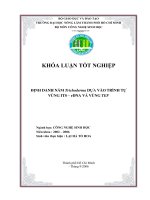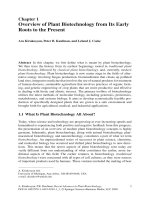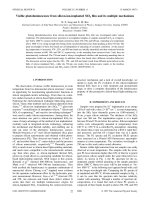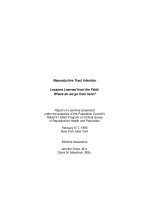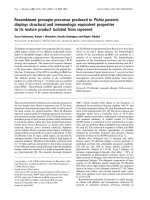Its true we came from slime
Bạn đang xem bản rút gọn của tài liệu. Xem và tải ngay bản đầy đủ của tài liệu tại đây (12.14 MB, 96 trang )
Ot
es
There Are Bugs in Your Bed
Heather Catchpole & Vanessa Woods
PICTURES BY Craig Smith
Pigs Do Fly
Terry Denton
PICTURES BY Terry Denton
Fashion Can Be Fatal
Susan Green
PICTURES BY Gregory Rogers
Your Hair Grows 15 Kilometres a Year
Diana Lawrenson
PICTURES BY Leigh Hobbs
Dinosaurs Never Died
John Long
PICTURES BY Travis Tischler
Crime Doesn’t Pay
Beverley MacDonald
CARTOONS BY Andrew Weldon
A Bushfire Burned My Dunny Down
Tracey McGuire
PICTURES BY Bill Wood
Frogs Are Cannibals
Michael Tyler
PICTURES BY Mic Looby
The Romans Were the Real Gangsters
John & Joshua Wright
PICTURES BY Joshua Wright
For Jean Radford
for her endless support and encouragement
First published in 2004
Copyright © text Ken McNamara 2004
Copyright © illustrations Andrew Plant 2004
Series design copyright © Ruth Grüner
All rights reserved. No part of this book may be reproduced
or transmitted in any form or by any means, electronic or mechanical,
including photocopying, recording or by any information storage
and retrieval system, without prior permission in writing from the
publisher. The Australian Copyright Act 1968 (the Act) allows a maximum
of one chapter or ten per cent of this book, whichever is the greater,
to be photocopied by any educational institution for its educational
purposes provided that the educational institution (or body that
administers it) has given a remuneration notice to Copyright Agency
Limited (CAL) under the Act.
Allen & Unwin
83 Alexander Street
Crows Nest NSW 2065
Australia
Phone: (61 2) 8425 0100
Fax: (61 2) 9906 2218
Email:
Web: www.allenandunwin.com
National Library of Australia
Cataloguing-in-Publication entry:
McNamara, Ken.
It’s true! we came from slime.
For children aged 8–12 years.
ISBN 1 74114 273 3.
1. Evolution – Juvenile literature. I. Plant, Andrew. II. Title.
576.8
Series, cover and text design by Ruth Grüner
Cover photograph: Ken McNamara and Serge Kozak/istockphoto.com
Set in 12.5pt Minion by Ruth Grüner
Printed by McPherson’s Printing Group
1 3 5 7 9 10 8 6 4 2
Teaching notes for the It’s True! series are available
on the website: www.itstrue.com.au
Contents
WHY LIFE BEFORE DINOSAURS?
1
Concrete cauliflowers 1
. Bugs that rock . Snug as a bug in mud
. Bugs and breakfast
2
Awash with gutless wonders 14
. Tracking trails and traces
. Fossil air mattresses
3
Eat or be eaten 24
. Fossil armour . Fossil evidence
. Trilobite ‘biscuits’ . Digging for fossil worms
4
‘My, what strange teeth you have,
Grandma’ 36
. Evolving a backbone . Gogo fish
5
Stepping out 50
. Rows of holes in sand . Sunbakers watch out!
. Footprints to fossils . Fish fingers
do the walking
6
Up, up and away 62
. Crusty continents . Greenhouse world
7
First prize in the ugly competition 72
. Sail of the century . Mammals finally arrive
. Therapsids (the what?)
Thanks 85
Timeline 86
Where to find out more 87
Index 88
W hy life b efore dinosau rs?
I’ve been collecting fossils since I was nine years old. Most people
grow out of this when they become adults. I never did. I still get a kick
out of discovering a new one and knowing what amazing creature
made it, aeons ago.
In this book you’ll discover some strange animals that lived in the
sea half a billion years ago (one looked like a vacuum cleaner with
teeth and five eyes). You’ll find out about scorpion-like animals bigger
than you, insects as big as parrots and spiders as big as cats (it’s true!).
You’ll find out who, or what, your long-lost ancestors looked like, and
whether we really did come from slime.
Join me on a 3-billion-year journey through time and discover
how all these strange creatures evolved on Planet Earth.
1
Concrete
cauliflowers
Life on Earth is always changing. A hundred million
years ago, dinosaurs tramped through the forests.
But long before that, an amazing number of animals
wandered and slithered over the land, or swam and
crawled in the seas. And if we went right back in time,
we’d find that the very first creatures, thousands of
millions of years ago, were so small that you couldn’t
see them. All you’d see is just a bit of slime . . .
Do you like cauliflowers? I do, so I’m going to
begin with them. What on earth, you might ask, do
cauliflowers have to do with life before the dinosaurs?
1
It’s a fair question. But, strange as it might seem, even
a cauliflower has a part to play in this story.
If your fridge is anything like mine, there’ll be all
sorts of strange and not so wondrous things lurking
inside. Perhaps there’s a cauliflower that’s been sitting
in there, minding its own business, for weeks.
Rather than the crisp, snowy white ball that went in,
it is now a crusty black lump that looks as though it’s
about to crawl out of the fridge on its own. This rather
smelly object looks uncannily like some rocks that
grow in shallow bays and lakes in Western Australia.
These rocks are called stromatolites (stro-mat-o-lites),
and they are very peculiar, not just because they look
like concrete cauliflowers, but because they grow.
2
That’s right, a rock that grows. And, believe it or not,
these rotten cauliflower look-alikes are the key to
understanding the very first life on Earth.
Bugs that rock
Like the cauliflower,
when it was once
happily living in a
field of cauli cousins,
stromatolites get
energy from the Sun.
This is because
these rocks are made
by bugs – actually,
a special type of bug,
called cyanobacteria (that means
blue-green bacteria). Yes, bacteria
– those invisible creatures that
make a nuisance of themselves
by getting up your nose and
giving you a cold, or worse.
3
Some are a bit more choosy about where they live and
hang out in the sea or in lakes and have this clever way
of making rocks. (And aren’t you glad this type don’t
live up your nose?)
Snug as a b ug in mud
These bugs are slimey, so any mud floating in the water
sticks to them. They are also able to cement mud grains
together (which is why you wouldn’t want these bugs
living up your nose). Adding mud grain to mud grain,
they build up stromatolites about as high as your knee.
That’s pretty impressive for a bug so small that when
you sneeze it out of your nose it’s travelling at about
160 km per hour. It’s like humans putting up a building
many kilometres tall (and we haven’t managed that
yet). In lakes and shallow bays in Western Australia,
these rocks are slowly growing – cementing mud
day by day, century by century. Many are more than
1000 years old. And these little bugs, or ones just like
them, have been doing this for a very, very, very long
time – 3500 million years in fact.
4
5
Now, you might think that it’s been a ‘long time’
since you last put on a clean pair of socks, but we’re
talking a seriously long time here – a mind-bogglingly
huge amount of time that’s almost too big to think
about. We can talk about dinosaurs first appearing
about 230 million years ago and humans just a few
hundred thousand years ago, but what does it really
mean?
Here’s a way of thinking about it that might help.
Hold this book in one hand. Keep reading. Stretch your
other hand out to the side. Yes, right out, pointing
6
your fingers. Now, just imagine that your nose
represents when life began on Earth. (I said when it
began – not where.) In this book we are going to travel
from your nose, across your face, down your arm, as far
as the beginning of your fingers. That would represent
when dinosaurs first appeared, around 230 million
years ago. They became extinct at the beginning of the
last joint of your finger. Humans appeared just a few
hundred thousand years ago – they are the thinnest
piece of fingernail you can snip off.
In this first chapter we are going to travel a long way
– from the tip of your nose to your wrist. And, as we
shall see, for much of this extremely long period
of time (from about 3500 to a little under
600 million years ago), there wasn’t much
on this Earth, except for bugs, bugs and
more bugs – oh, and lots of slime.
7
Dinosaurs
appear
Bugs and breakfast
If you look at a map of Australia, the big lump in the
top left corner is the Pilbara region. Here all is red,
green and blue – the red of the rocks, the green of
the prickly spinifex grass, and the blue of the sky.
In some of these red rocks we find the oldest fossils
in the world. But they are not fossils of bones or
shells. Amazingly, they’re fossilised stromatolites,
a bit like the ones still growing today in other parts
of Western Australia.
In the 1980s, scientists collected some dark grey,
flinty rocks that are found with the fossil stromatolites.
They cut the rocks with a special diamond saw, into
really thin slices, thinner than tissue paper – slices so
thin you can see through them. Then, using a very
powerful microscope, the scientists were able to find
the actual fossilised remains of the bugs that made
the stromatolites.
We owe a lot to these bugs, particularly the
cyanobacteria. Incredible as it may seem, they gave us
the oxygen we breathe. Even more surprisingly,
8
they made the mountains of iron ore in the Pilbara.
These are mined and turned into the cans which
contain the baked beans you had for breakfast and the
car that you were driven to school in.
Speaking of baked beans . . . Before there was
oxygen in the air, a few thousand million years ago,
there was a lot of methane. (That’s the unmentionable
gas that appears when you’ve eaten too many baked
beans.) There was also a lot of another gas, carbon
dioxide. Like plants today, the ancient blue-green bugs
turned the carbon dioxide into sugars, using energy
from sunlight. A side product was the gas oxygen.
When these bugs first
started doing this,
oxygen bubbled into
the sea. This caused
iron minerals dissolved
in the sea to
turn into rust.
9
For hundreds of millons of years the sea continued to
produce rust. These iron-rich muds have since turned
into the great mountains of iron ore that today are
mined in the Pilbara, to make your baked bean can,
your parent’s car, and so on.
The little bugs kept on soaking up the carbon
dioxide and spitting out the oxygen. Once the air
became rich in breathable oxygen (probably about
your shoulder on our trip down your arm), some
of these simple bacterial cells came together, some
living inside others. And so evolved slime and the first
seaweeds (near your elbow). Some time after that,
though we don’t know exactly when, other cells got
together and made
cells that later
evolved into the
first animals.
First seaweeds appear
10
(‘Evolved’ means ‘changed over a very long period of
time’ – see pages 12–13.) We are still hunting for their
fossilised remains. Maybe they are so tiny that we won’t
be able to find them.
So, we owe a lot to those early slimy bugs. Not only
did they give us the air we breathe and our tin cans, but
they’re also our
extremely long-, long-,
long-lost ancestors. In between us and them
are some fearsome and far-fetched creatures, as you’ll
see when you read on.
11
MAKING EVOLUTION HAPPEN
By looking at fossils of different ages we can see
that animals, plants, fungi and bacteria have changed
– very, very slowly – over time. We say they have
‘evolved’, and we call this slow process of change
‘evolution’. So how does evolution happen?
Well, imagine two tigers racing to catch an antelope.
The one that is the better hunter – maybe the one
that runs faster – will get to it first and then have
some food for its cubs. It is more likely to survive
and raise young. At least some of the cubs will
be like the parent – they’ll be successful hunters.
Gradually more and more of the surviving tigers will
be faster runners. Over time they may become so
different from the original tigers that they no longer
breed with them, and so a new species evolves.
Similarly, fish with teeth and jaws evolved from the
earliest fish that had neither. Teeth made these later
fish more successful at catching their prey.
This has happened for other animals, and plants
as well. The ones best equipped to get food or
avoid being eaten are the ones best suited to their
surroundings, and so they survive and multiply.
The English scientist Charles Darwin was the person
who worked out how evolution happened.
He called it ‘natural selection’.
12
But how would some
tigers evolve more powerful legs?
How did fish teeth change from being
tiny, harmless bumps to the massive fangs
of a great white shark?
The tigers did this by growing legs or teeth
a little faster or for a little longer, and ended up
bigger and more powerful. The fish did it much
the same way with their teeth. These changes
were then passed on from parents to offspring
over many generations.
In the 1930s scientist realised that what we look
like and how fast we grow was determined by
chemical messengers in our cells, called genes.
So three things make up evolution:
natural selection; changes in how fast
and for how long we grow; and genes
that pass these changes on
to the next generation.
2
Awash with
gutless wonders
You are very annoyed. You spent yesterday planting
25 daffodil bulbs for your mum. Today is Mother’s Day.
OK, the chance of there being 25 bright yellow flowers
nodding and smiling in the breeze was pretty low.
But it’s the thought that counts. Just give them a couple
of months. You went out into the garden to check
your handiwork. And that’s when you saw the mess.
Your beautifully prepared garden has been dug up
by the neighbour’s b****y cat! He’s dug
a hole so deep that it looks as if
he’s been digging for gold.
14
Half of your carefully planted bulbs have been dug up
and kicked far and wide. Even worse, after doing his
evil, smelly business in the hole he didn’t even cover it
up properly. Yuk.
So what’s this got to do with fossils? Quite a lot,
actually. Firstly, the word ‘fossil’ comes from the Latin
word fossilis, meaning ‘dug up’ – just what the cat did.
A lot of words in palaeontology (the study of ancient
life) come from Latin, which is not surprising really.
It’s a dead language and fossils are very, very dead!
But the other thing about your exploded flowerbed
is that you have assumed the cat did it. Did you see
the cat do it? No. Then how do you know it was the
cat, and not some half-crazed leprechaun looking for
gold? You know because, like a detective and like a
palaeontologist, you’ve used clues to work out who did
the evil deed. What you have is some disturbed soil
– and the cat’s poo. That’s evidence enough.
15
Tracking trails and traces
Amazing as it may seem,
the oldest known
animal fossil has
something in
common with the
cat’s night-time
adventure. This very old
fossil is called a trace fossil,
because it records the traces
of animal activity. Not all fossils are parts of a creature,
like bones or shells. Some, such as dinosaur footprints,
or the trails left in the sand by some little worm, are
trace fossils. If your daffodil bed somehow amazingly
got preserved for million of years and turned into
rock, then the cat’s diggings would be a trace fossil.
They may not tell us much about what the animals
looked like, but trace fossils tell us a lot about how they
behaved. No, I don’t mean whether they were good or
bad, but whether they crawled or slithered or burrowed
– things like that.
16
For thousands of millions of years there were no
other life forms on Earth but bugs. Lots and lots of
bugs. From the tip of your nose until about your
elbow, there were just bugs. Then came the seaweeds
that I mentioned before. We’ve found fossil remains
of them. Sometimes we see them as spirals in
2000-million-year-old rocks in America, other times
as little rows of beads in rocks 1300 million years old
in Western Australia. This is long before any animals
showed up.
Then we see the first trails and scrapings made
in sand by animals, and somehow amazingly preserved
in rock for about 700 million years. They are like a
faraway snapshot in time. Unlike your cat, we have no
idea what the animal looked like that left its trail in
the sands of an ancient sea. It was probably something
like a tiny worm. More recent trace fossils left by
animals often form complex patterns, like spirals,
or form burrows in the sand. This shows us that the
animals that made them were changing and becoming
more complex over millions of years. This is evolution
at work again.
17

